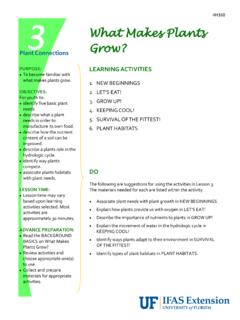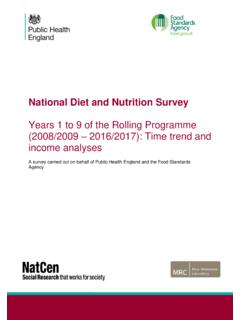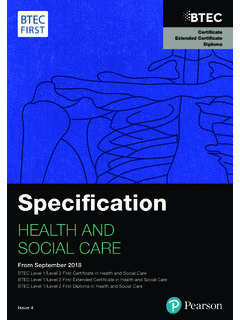Transcription of DETERMINATION OF VITAMIN C CONTENT IN COMMERCIAL …
1 Journal of Hygienic Engineering and Design124 Original scientific paperUDC DETERMINATION OF VITAMIN C CONTENT IN COMMERCIAL FRUIT JUICES BY VOLUMETRIC AND SPECTROPHOTOMETRIC METHODSA riola Devolli1*, Merita Stafasani1, Edlira Shahinasi1, Frederik Dara2, Hikmete Hamiti31 Department of Chemistry, Faculty of Biotechnology and Food, Agricultural University of Tirana, Pajsi Vodica, Koder-Kamez, 1029 Tirana, Albania2 Department of Applied Mathematics, Faculty of Natural Sciences, University of Tirana, Boulevard Zogu I nn, 1001 Tirana, Albania3 National Food Authority, Kuk s-Prizren Street nn, 8501 Kukes, Albania*e-mail: Ascorbic acid known as VITAMIN C is the main constituents of fruit juice and it is an essential antioxidant.
2 Presence of this organic acid plays an important role in human health and on the shelf life of the product. The purpose of this study was the DETERMINATION of VITAMIN C CONTENT in some imported COMMERCIAL fruit juices traded in Albania. Samples were chosen randomly in Tirana s hypermarkets. CONTENT of ascorbic acid was determined by redox titration with iodine solution and UV-spectrophotometric methods using potassium permanganate as a chromogenic reagent. Results were analyzed by two-sample t-test equal means.
3 CONTENT of ascorbic acid in COMMERCIAL fruit juices determined by volumetric methods varied from mg/100mL to mg/100mL. The level of ascorbic acid according to the spectrophotometric method varied from mg/100mL to mg/100mL. Based on two-sample t-test for equal means of VITAMIN C for the CONTENT in fruit juices revealed that there is no significant difference between two methods. However, it was noticed that the level of VITAMIN C CONTENT was about three times higher than one declared on the labels of analyzed samples.
4 Approximately 40 - 50% of the amount of ascorbic acid is lost after opening the package of COMMERCIAL fruit juices and seven-day storage at the temperature of 4 Celsius words: VITAMIN C, COMMERCIAL fruit juices, Volumetric method, UV-spectrophotometric method, IntroductionFruit juices are consumed throughout the world due to the health benefits, the pleasant taste, their characteristic aroma and flavor. Natural fruit juices are good source of vitamins, minerals, soluble and insoluble fibers and major source of valuable bioactive compounds essential for human health [1, 2].
5 Due to their potential nutritional and biological fruit juices are foods with multiple implications for body balance [3]. Consumption of fruit juices as a part of a normal diet to prevent or treat cardiovascular diseases is becoming more fashionable [4]. Fruit juice is unfermented but fermentable liquid or juice intended for direct consumption, obtained from the edible portion of sound, appropriately mature and fresh fruit by mechanical extraction process and preserve, exclusive by chemical and physical means [5].
6 Fruit juice as well is a natural fluid that can be obtained by crushing or squeezing of fresh fruits or reconstituted concentrates [6, 7]. The most common ingredients in juices are fruits or reconstituted juice, water, preservatives, sugar, acid and color [8]. Fruit juices may be produced either by extracting the natural fruits with water resulting in water extractable juices. Those juices have all essential physical, chemical, organoleptic and nutritional properties of the fruits they are produced from [9].
7 In terms of chemical composition fruits consist of water and dry matter. The dry matter contains considerable amounts of vitamins ( VITAMIN E and C), acids, sugars, polysaccharides, pectin, cellulose, polyphenols and minerals. Journal of Hygienic Engineering and Design125 Minerals and vitamins could be added to enrich fruit juices [3]. According to Leahu et al., [3] consumption of fruit juices with pulp is recommended, being used in the treatment and prevention of cardiovascular diseases, liver disease, etc., natural juices are common sources of vitamins (mainly VITAMIN C) and minerals in daily dose.
8 Some manufacturers produce fruit juices from raw materials other than the fruit, or use concentrates in quantities below the legal requirements [10]. Preservatives such as sodium benzoate, sulphur dioxide, sorbic acid and ascorbic acid may be used to extend fruit juice shelf-life. These preservatives works effectively at pH usually below , therefore amount of acid added has to maintain the proper pH value. The commonly used acid is citric acid which should not exceed range - % in fruit juices [11].
9 The anti-oxidant components of fruit juice have beneficial long term health effects, such as decreasing the risk of cancer and heart disease [12]. VITAMIN C does not provide energy to the body but it is essential and necessary nutrients for the growth of the body and also associated with the enzyme function in the body. It plays an important role not only in collagen biosynthesis, but also in iron absorption and immune response activation [13, 14, and 15]. The main sources of VITAMIN C are fruits and vegetables such as oranges, lemons, limes, citrus fruits, strawberries, melons, peppers, tomatoes, leafy vegetables, and potatoes spinach and etc.
10 [16]. Even a healthy diet contains sufficient quantities of ascorbic acid; the body requires more of the VITAMIN after serious injury, major surgery, burns and when exposed to extremes temperature [14]. According to some previous studies minimum daily requirement of VITAMIN C for adults is 60 mg. The recommended daily doses are 25 to 30 mg/1000 kcal [17, 18, and 19]. In some cases, excessive quantities of ascorbic acid may result in the inhibition of natural processes occurring in food and can contribute to taste deterioration [20].





